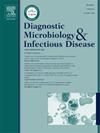Higher detection rates of Mycoplasma pneumoniae in children with acute respiratory tract infections using oropharyngeal swabs compared to nasopharyngeal swabs
IF 1.8
4区 医学
Q3 INFECTIOUS DISEASES
Diagnostic microbiology and infectious disease
Pub Date : 2025-08-21
DOI:10.1016/j.diagmicrobio.2025.117078
引用次数: 0
Abstract
Background
Head-to-head comparisons of nasopharyngeal swabs (NPS) and oropharyngeal swabs (OPS) for microbiological analysis in pediatric patients with acute respiratory tract infections (ARTI) remain limited. This study aimed to evaluate the concordance of NPS and OPS in identifying various etiologies among children with ARTI.
Methods
Paired NPS and OPS samples were collected from 326 children with ARTI and analyzed for 15 respiratory pathogens using suspension microarray.
Results
NPS demonstrated a higher overall microbiological yield than OPS (79 % vs. 73 %, P <0.05). The five most frequently detected pathogens were respiratory syncytial virus, Haemophilus influenzae, Mycoplasma pneumoniae (MP), Moraxella catarrhalis (MC), and rhinovirus (RV). NPS exhibited significantly higher sensitivity for MC, RV, and parainfluenza viruses compared to OPS (P <0.01). Strikingly, MP detection rates were substantially higher in OPS than in NPS (84 % vs. 29 %, P <0.001).
Conclusion
While NPS generally yields better results for most pathogens, OPS is superior for MP detection. Combined sampling of NPS and OPS may reduce missed ARTI diagnoses in clinical practice.
口咽拭子对急性呼吸道感染患儿肺炎支原体的检出率高于鼻咽拭子
背景:在儿科急性呼吸道感染(ARTI)患者中,鼻咽拭子(NPS)和口咽拭子(OPS)用于微生物学分析的直接比较仍然有限。本研究旨在评估NPS和OPS在识别ARTI患儿各种病因方面的一致性。方法采集326例ARTI患儿的西班牙NPS和OPS样本,采用悬浮芯片检测15种呼吸道致病菌。结果snps的微生物总产率高于OPS (79% vs. 73%, P <0.05)。最常见的五种病原体是呼吸道合胞病毒、流感嗜血杆菌、肺炎支原体(MP)、卡他莫拉菌(MC)和鼻病毒(RV)。与OPS相比,NPS对MC、RV和副流感病毒的敏感性显著提高(P <0.01)。引人注目的是,OPS的MP检出率明显高于NPS(84%对29%,P <0.001)。结论NPS法对大多数病原菌的检测效果较好,而OPS法对MP的检测效果较好。NPS和OPS联合抽样可减少临床ARTI漏诊。
本文章由计算机程序翻译,如有差异,请以英文原文为准。
求助全文
约1分钟内获得全文
求助全文
来源期刊
CiteScore
5.30
自引率
3.40%
发文量
149
审稿时长
56 days
期刊介绍:
Diagnostic Microbiology and Infectious Disease keeps you informed of the latest developments in clinical microbiology and the diagnosis and treatment of infectious diseases. Packed with rigorously peer-reviewed articles and studies in bacteriology, immunology, immunoserology, infectious diseases, mycology, parasitology, and virology, the journal examines new procedures, unusual cases, controversial issues, and important new literature. Diagnostic Microbiology and Infectious Disease distinguished independent editorial board, consisting of experts from many medical specialties, ensures you extensive and authoritative coverage.

 求助内容:
求助内容: 应助结果提醒方式:
应助结果提醒方式:


